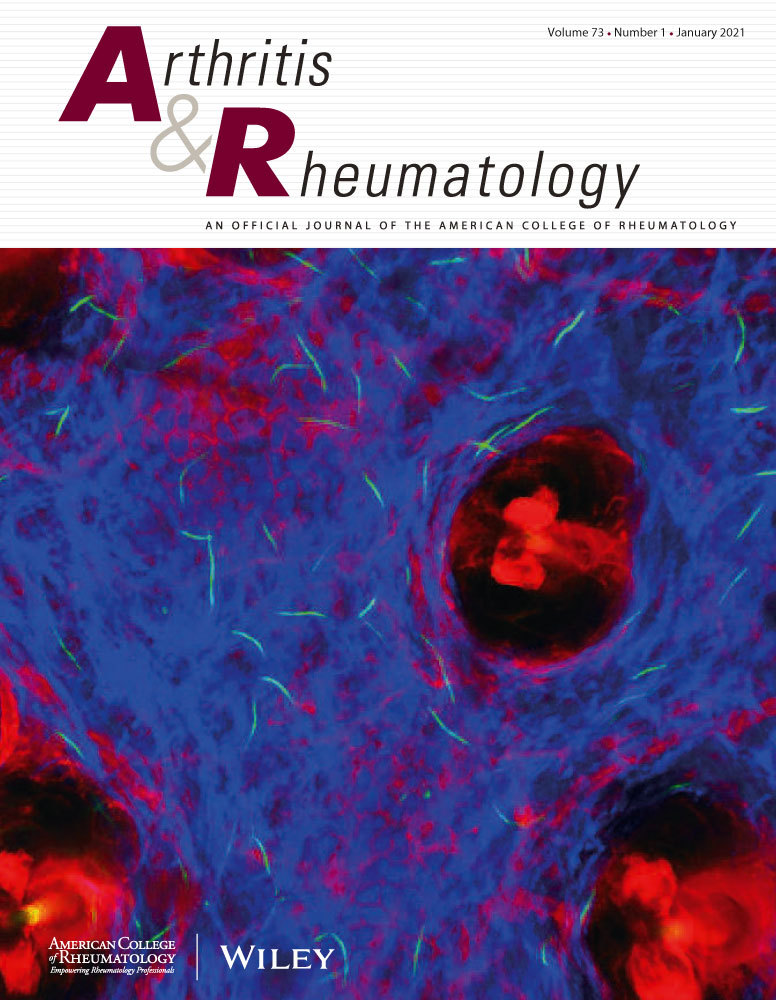Longitudinal Analysis of Somatic Mosaicism and Clonal Hematopoiesis in Cryopyrin-Associated Periodic Syndrome.
IF 10.9
1区 医学
Q1 RHEUMATOLOGY
引用次数: 0
Abstract
OBJECTIVE Cryopyrin-associated periodic syndrome (CAPS) is an autoinflammatory disease caused by gain-of-function mutations in NLRP3. Although somatic NLRP3 mosaicism is increasingly recognized, it remains unclear how variant allele frequency (VAF) changes over time and whether disease onset age reflects differences in somatic mutation dynamics. This study aimed to analyze the longitudinal VAF trends and their correlation with clonal hematopoiesis (CH) in patients with CAPS mosaicism. METHODS We analyzed NLRP3 VAF in blood and various tissues, including dried umbilical cord (DUC) using digital PCR and deep amplicon sequencing. Whole-exome and single-cell genome sequencing were performed to evaluate CH-related mutations. RESULTS We included 15 patients with VAFs of 4.3% to 34.9%. In the 12 early-onset cases, VAFs were generally consistent across various tissues and did not increase over time, including the DUC. Conversely, in the three late-onset cases, VAFs were particularly high in myeloid cells. Notably, in one late-onset case, no mutations were detected in DUC. After disease onset, VAFs exhibited 2.9%-to-10.6% and 6.2%-to-16.4% increase in the whole blood and neutrophils over 6.4 and 4.4 years, respectively, showing a clonal expansion of NLRP3-mutant cells. Single-cell genome sequencing revealed frequent co-occurrence of NLRP3 and TET2 mutations in the same cells, with a gradual increase in both VAFs over 3 years, in one late-onset case. CONCLUSION In early-onset cases, the VAFs were comparable across various tissues and did not increase over time. Mutations in late-onset cases were enriched in myeloid cells, and VAFs were increased, suggesting a link to CH.低温素相关周期综合征患者体细胞嵌合体和克隆造血的纵向分析。
目的红霉素相关周期综合征(CAPS)是一种由NLRP3功能获得性突变引起的自身炎症性疾病。尽管体细胞NLRP3嵌合体越来越被认识到,但变异等位基因频率(VAF)如何随时间变化以及疾病发病年龄是否反映了体细胞突变动力学的差异仍不清楚。本研究旨在分析CAPS嵌合患者VAF的纵向趋势及其与克隆造血(CH)的相关性。方法采用数字PCR和深度扩增子测序的方法分析NLRP3 VAF在血液和包括干脐带(DUC)在内的各种组织中的表达。全外显子组和单细胞基因组测序评估ch相关突变。结果纳入15例vaf患者,发生率为4.3% ~ 34.9%。在12例早发病例中,vaf在各种组织中基本一致,并且不随时间增加,包括DUC。相反,在三例迟发性病例中,VAFs在髓细胞中特别高。值得注意的是,在一个迟发性病例中,DUC未检测到突变。发病后,VAFs的全血和中性粒细胞在6.4年和4.4年分别增加2.9%- 10.6%和6.2%- 16.4%,显示nlrp53突变细胞的克隆扩增。单细胞基因组测序显示,NLRP3和TET2突变在同一细胞中频繁共存,在1例晚发病例中,两种VAFs在3年内逐渐增加。结论在早发病例中,不同组织的vaf具有可比性,且不随时间增加。迟发病例的突变在髓细胞中富集,vaf增加,表明与CH有关。
本文章由计算机程序翻译,如有差异,请以英文原文为准。
求助全文
约1分钟内获得全文
求助全文
来源期刊

Arthritis & Rheumatology
RHEUMATOLOGY-
CiteScore
20.90
自引率
3.00%
发文量
371
期刊介绍:
Arthritis & Rheumatology is the official journal of the American College of Rheumatology and focuses on the natural history, pathophysiology, treatment, and outcome of rheumatic diseases. It is a peer-reviewed publication that aims to provide the highest quality basic and clinical research in this field. The journal covers a wide range of investigative areas and also includes review articles, editorials, and educational material for researchers and clinicians. Being recognized as a leading research journal in rheumatology, Arthritis & Rheumatology serves the global community of rheumatology investigators and clinicians.
 求助内容:
求助内容: 应助结果提醒方式:
应助结果提醒方式:


